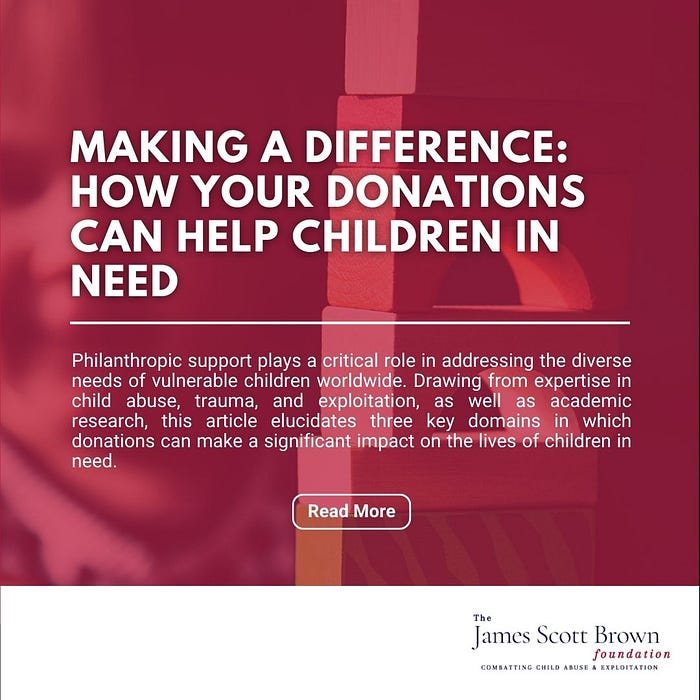Making a Difference: How Your Donations Can Help Children in Need by James Scott Brown Foundation
by James Scott Brown Foundation

Abstract:
Philanthropic support plays a critical role in addressing the diverse needs of vulnerable children worldwide. Drawing from expertise in child abuse, trauma, and exploitation, as well as academic research, this article elucidates three key domains in which donations can make a significant impact on the lives of children in need. By contributing to targeted interventions, individuals can help create a brighter future for these children.
- Enhancing Access to Education:
Donations can support organizations that focus on educational initiatives, such as building schools, providing scholarships, and offering tutoring programs. Ensuring access to quality education for children in need can have a transformative impact on their future prospects and contribute to breaking the cycle of poverty (Psacharopoulos & Patrinos, 2018).
2. Supporting Health and Nutrition Programs:
Contributing to organizations that address children’s health and nutrition needs can significantly improve their well-being. Donations may fund initiatives such as vaccination campaigns, clean water projects, and nutrition programs, which can lead to better health outcomes and quality of life for vulnerable children (Black et al., 2013).
3. Providing Care and Support for Children in Crisis:
Donations can help organizations that offer care and support to children who have experienced abuse, trauma, or exploitation. Financial contributions can facilitate access to essential services such as counseling, legal assistance, and safe housing, thus aiding the healing process and promoting the child’s long-term recovery (Wolfe et al., 2003).
Conclusion:
Donations can have a profound impact on the lives of children in need, fostering positive change in areas such as education, health, and crisis support. By contributing to carefully selected organizations and initiatives, individuals can make a tangible difference in the well-being and future prospects of vulnerable children.
References:
Black, R. E., Victora, C. G., Walker, S. P., Bhutta, Z. A., Christian, P., de Onis, M., … & Uauy, R. (2013). Maternal and child undernutrition and overweight in low-income and middle-income countries. The Lancet, 382(9890), 427–451.
Psacharopoulos, G., & Patrinos, H. A. (2018). Returns to investment in education: A decennial review of the global literature. Education Economics, 26(5), 445–458.
Wolfe, D. A., Crooks, C. V., Lee, V., McIntyre-Smith, A., & Jaffe, P. G. (2003). The effects of children’s exposure to domestic violence: A meta-analysis and critique. Clinical Child and Family Psychology Review, 6(3), 171–187.
Read more at the James Scott Brown Foundation.
Comments
Post a Comment